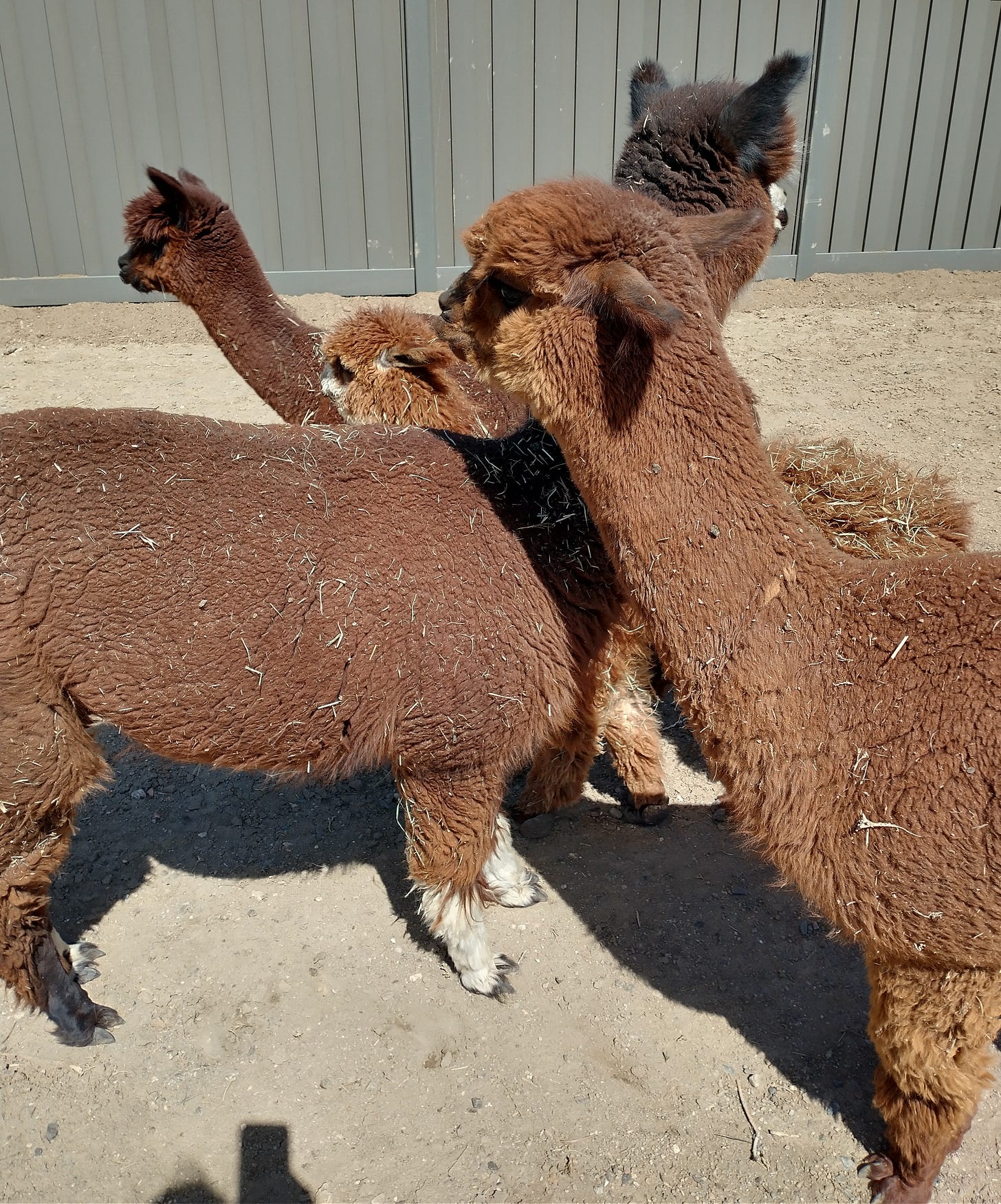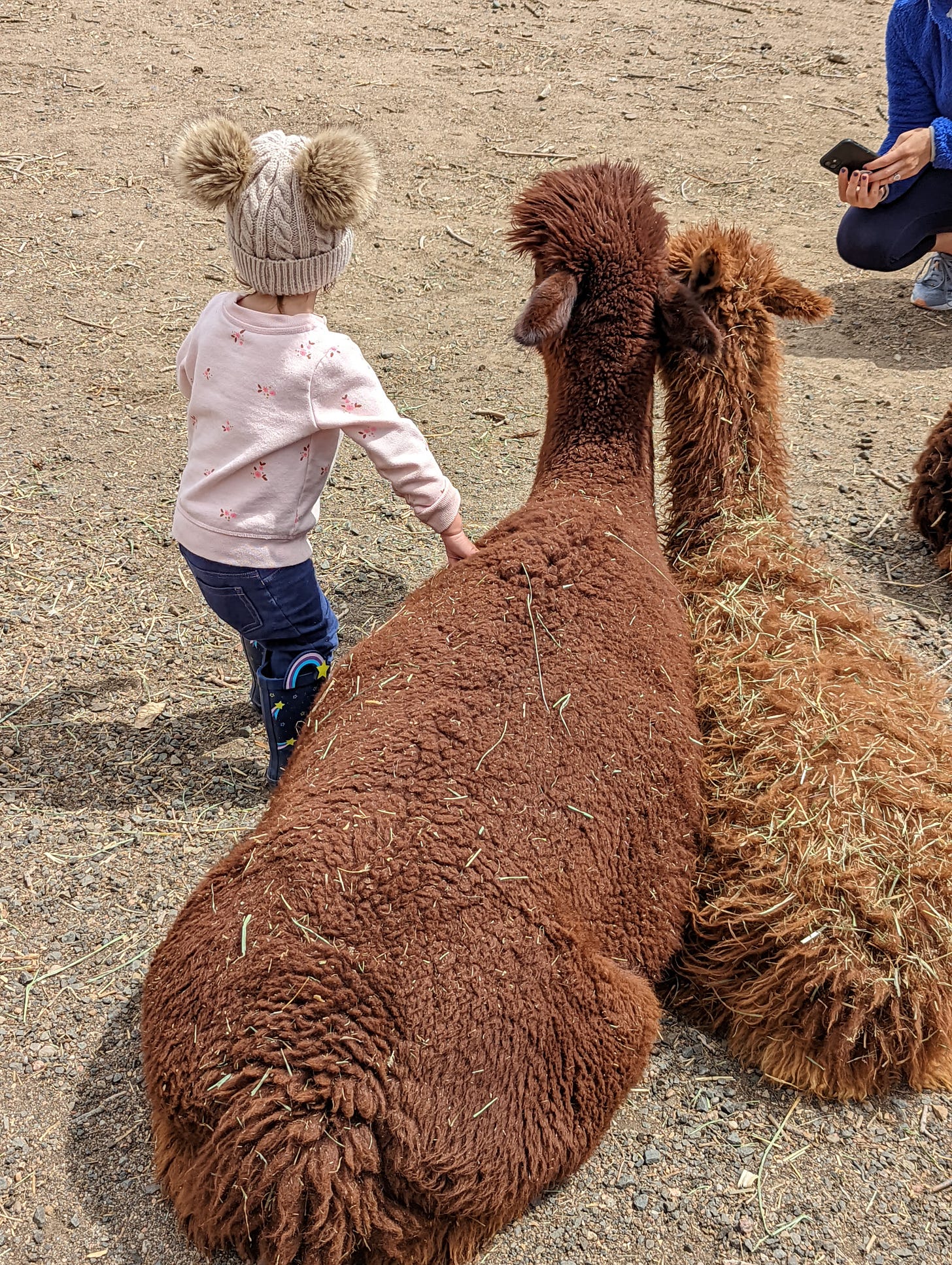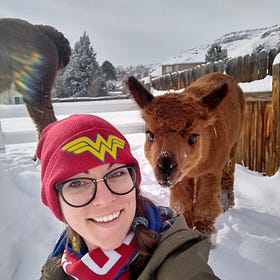There’s a whole genre of YouTube videos in which “experts” analyze the body language demonstrated in interactions between, for example, members of the British Royal Family, or celebrities in high-profile court cases or breakups. These experts take short clips of film, freeze them, draw circles and arrows to highlight specific movements or postures, and then explain what they mean about individual people’s attitudes or relationships.
These videos can be fun to watch, but also problematic. Often they frame things to fit a popular narrative. And on a personal level, haven’t we all misread another person’s body language?
Before the alpacas, I worked in a jail library where there were occasional moments when a member of our small team noticed a person’s body language and intuited that something was going on with them. Sometimes the cues were obvious. Once, as I walked down the hall, I saw a young man pacing and rolling his shoulders while he waited for his law library appointment. I was not surprised when the door opened and he was angry with me.1 Other times, it was harder to pinpoint what exactly triggered our intuition that something was off. How we read body language can have a lot to do with our biases and backgrounds, emotions, and attitudes toward the other person, in addition to the scientific elements.
As for those YouTubers, “What you see is often more entertainment than science. It can contribute to misinformation,” says Vincent Denault, a communication researcher at the University of Montreal (PopSci).
I think alpacas are helpful, if non-human, examples of how body language can be misread. Alpacas give some fairly obvious cues alongside others that can have multiple meanings—or mean nothing at all.
And there’s culture to account for, too. Although I have spent four years living among the alpacas, observing their interactions and learning to understand their behavior, I am not a native speaker of their language. For every bit of alpaca body language I see and understand, I am sure there are myriad nuances I don’t even know to look for. I will explain what I do know.
Let’s start with some moments demonstrating a range of body language. In this video, I cover interactions with varying degrees of alpacas acting annoyed. You can also see neutral, submissive, and curious behaviors in these clips:
Submissive
For a young alpaca, a raised tail is a submissive posture. It says, “I’m just a little baby!”
Annoyed
Look for a jerking chin, raised ears, and a raised tail. Because I am well-known to her, Theodora even gets in my face a bit. Puffs of air, precursing spit, are a good indicator that you need to back off.
Neutral
Often, visitors ask if the alpaca’s ears show emotion, like a cat’s do. The common understanding is that when a cat’s ears turn backward, they’re annoyed. Ears back can be a neutral posture for alpacas. So can ears up. Mostly, the direction an alpaca's ears point shows you if they are listening to something. As prey animals, they spend energy scanning the environment for threats. Ears back tends to mean they’re relaxed. Ears up is paying attention. Except for Clementine, who regularly has ears pointing in two different directions because she’s just a silly goose.
Here are several examples of what I think a neutral, relaxed alpaca looks like:
Curious
When an alpaca is curious about something, they kind of bob and weave at it. Swooping in for a sniff and then backing off quickly, uncertain. If they are curious about you, they will sniff your face. And if you hold still and let them do it, you might get to pet them. (More on this in the etiquette post linked below.)
Curiousity looks so cute on an alpaca:
Cushing
A cushed position is a submissive or relaxed position for an alpaca. This is how they sit and chill and generally, they will only do it if they feel safe enough to believe they won’t have to run away. Pay attention, though, to other cues. Our alpacas cush when we have visitors, letting people pet them, but they also give off subtle cues that they are not totally comfy with the situation. The way Luna and Miss Firecracker lean together here shows that, although they are cushed, they also feel a little stressed, perhaps with Miss Firecracker wishing to protect her baby:
Love
Alpacas show affection by sitting close together or tapping their noses. For more on that, see the post on best friends linked below. We can talk about alpaca reproduction another time.
Alerted
An alert alpaca comes in degrees. At their most alert, alpacas vocalize with screams or hums. But before then, they usually cluster together, crossing their necks, so they have a 360° view. The smallest degree of alertness comes with those raised ears mentioned above.

Angry
If you do not back off after the annoyed cues, you will likely get spit on or kicked. With each other, they will also pull ears, lock necks, and shove each other with their shoulders. It’s hard to miss angry cues because alpacas are usually so stoic.
Here’s a fight:
Subtleties and Group Dynamics
Because alpacas are herd animals, it helps to look at the group in addition to the individuals. Each alpaca has her own personality and relationships within the herd. The alpacas tend to move as a group, but how they move can indicate how they feel. When our alpacas feel safe, they are more likely to fan out across the pasture to look for little bits of green to eat. They will sprawl out and nap. If you look closely, you’ll notice that one of them is on watch, awake, scanning the terrain to keep an eye on the rest. Toward evening, they drift closer together for safety. But, anytime something puts them on edge, they huddle up.
Within the range of alpaca attitudes, it can be easy to miss the subtle difference between neutral and alert. Some alpacas are more expressive than others. Theodora always lets us know when she is annoyed. Miss Firecracker watches me suspiciously but does not emote much. Clementine is very easygoing but is the only alpaca in our herd I have seen spit at a person with no warning. (Sorry, Uncle David!) Like humans, alpacas communicate in a variety of styles, and knowing the individuals is more helpful than making broad assumptions about what they are trying to say based on posture. For example, in people crossed arms can mean hostile, closed off, or “I’m cold.”
Sure, I want to know the juicy details about Harry and William’s tense relationship based on a short video clip (just for example), but body language is only one part of the communication puzzle.
If you like this post, you may be interested in these others on alpaca etiquette and friendships:
Alpaca Etiquette 101
When I enter the pasture, my buddy Clementine trots over to meet me. I bend over to look her in the eye and she softly sniffs my face. Cooing a greeting to this sweet girl, I gently tip my forehead into her topknot—the fluff of fleece between her ears. I reach a hand slowly to brush her neck. She jumps back. I will not pet her today. But, still, Clement…
Sometimes Spit Isn't Serious
Alpacas have best friends. So do cows, elephants, and primates (including humans). Geese, elephants, and rattlesnakes help care for each other’s young. For a long time, observations on animal friendship were treated like anthropomorphism, but recently more research has focused on
I made a mistake on his photocopies. I apologized and fixed the error, but the chip on his shoulder was telling him that I did it on purpose. “Why would I do that?” I asked. It took six months of perfect library assistance for him to trust me just a little.







Thank you for this and all of your posts. I work with my young daughter on my friend’s alpaca farm and so we spend a lot of time with them. These posts are wonderful to read x
I am absolutely delighted to stumble upon this today. ☺️